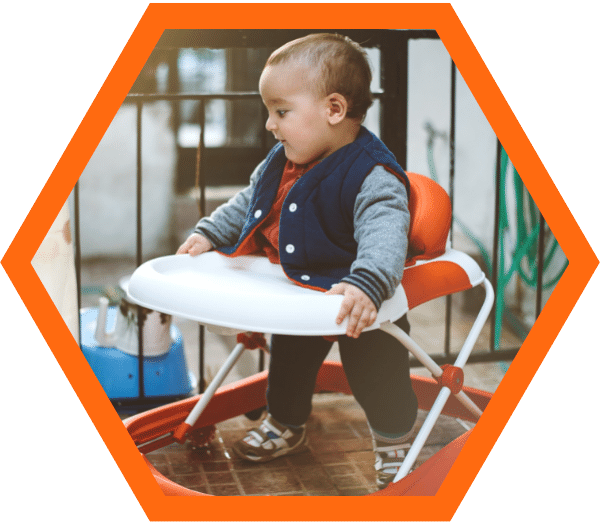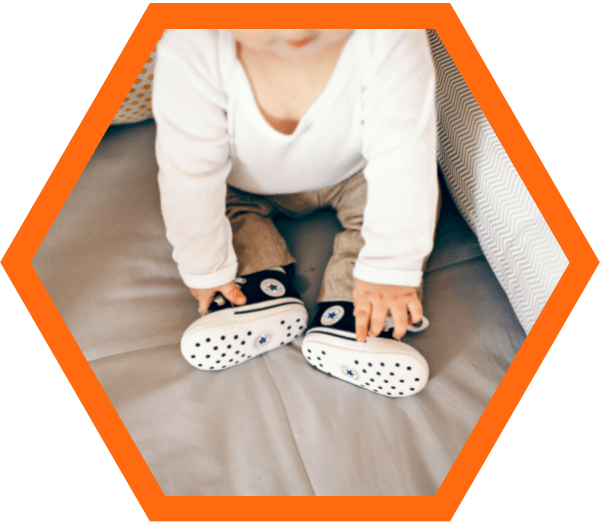Beginning to move around
There are lots of ways to promote physical development in babies and young children.
It is really important that you maximise movement opportunities for your children, so that they can develop their motor skills and to encourage movement and activity for life.
You can read through advice and help for a number of topics below:







Tummy time
Tummy time helps to strengthen the muscles in their neck, shoulders, back and hips, which will help them learn to hold their head up, roll over, sit, crawl and eventually walk.
It is important to lay your baby on their tummy and encourage them to lift their head to look around. Doing this helps to strengthen the muscles in their neck, shoulders, back and hips, which will help them learn to hold their head up, roll over, sit, crawl and eventually walk. Tummy time also reduces the risk of developing flattening at the back or one side of your baby’s head.
How you can help
You can start doing tummy time from birth by lying your baby on your chest – but only do this when you’re wide awake and unlikely to fall asleep.
Little and often is best to begin with. Gradually increase the amount of time you do this day by day. Then, when your baby is ready, try doing tummy time on the floor. If your baby has difficulty lifting their head, you can roll up a towel and put it under their armpits. Put some toys nearby for them to reach out to.
Only do tummy time when your baby is awake and alert, and you’re there to keep an eye on them.
Aim for around 20 to 30 minutes a day of tummy time by the time your baby is 3 or 4 months old, until they are able to roll over on their own.
Learn five essential tummy time moves
Download
Download the Tummy Time Table app to log the times, duration and experience of your babies’ tummy time.
What to do if you have concerns
If they can’t lift their head and prop themselves up on their forearms when you put them on their tummy and this doesn’t seem to improve speak to your health visitor.
If your baby is not turning their head very easily you might need a referral to Children’s Physiotherapy.
Other useful links
You might also find the Association of Paediatric Chartered Physiotherapist’s leaflet Head Turning Preference and Plagiocephaly useful.

Rolling and sitting
Rolling develops the muscles in your baby’s tummy and back, which helps them to gain the strength they need to sit and move between positions.
It allows them to explore and gain new experiences, which helps with other areas of development.
Babies learn to roll to grasp for toys that are outside of their reach and to explore their environment.
Why is rolling important in a baby’s development?
Rolling develops the muscles in your baby’s tummy and back, which helps them to gain the strength they need to sit and move between positions. It allows them to explore and gain new experiences, which helps with other areas of development.
How can I encourage my baby to roll?
The NHS have produced a useful guide to help you understand what you can do to encourage your baby to sit and crawl.
Other useful tips:
- Allow your baby to spend lots of time every day on the floor playing in different positions.
- Encourage your baby to roll throughout the day.
- Place toys just out of your child’s reach around them on the floor to encourage them to try to roll.
- Ensure your child isn’t always placed under a baby gym when they’re on the floor, where toys are in easy reach above them.
- Avoid placing your child in any type of seat – including bouncy chairs, push chairs, car seats, door bouncers and baby walkers – for long periods, as this may prevent them from learning how to roll.
Tips and ideas
If you’re moving them from their front to their back, or from their back to their front, help them to roll rather than picking them up and placing them:
Rolling from tummy to back
Babies usually first learn to roll from their tummy to their back by pushing up unevenly on their hands and rolling to one side. It’s really important to place your baby on their tummy to play frequently throughout the day so they have the chance to practice this skill.
Rolling from back to tummy
- With your baby lying on their back, gain their interest in a toy and then place it to the side of their head
- Hold the leg on the opposite side of the toy at the knee, and slowly bring it across their body so they roll onto their side and then onto their tummy towards the toy
- Do this slowly so your baby can join in with the movement and do some of it for themselves
- They might need some help to bring their arms out in front if they get trapped underneath them as they roll
How can I encourage my baby to sit?
- Sit with your baby on the floor, supporting them around their body.
- Put toys in front of them for them to play with. Babies need to prop themselves up on their hands as they learn to sit. You can help them learn this by placing sturdy toys in front of them to lean on.
- Give them as little support as they need so they use their tummy and back muscles.
- As they improve, you can move your hands from their body to their shoulders or their hips. You might like to sit your baby in a play ring to give them some support. Place toys in or on the ring so they can play.
How can I help my baby learn to get from lying to sitting?
- Start with your child lying on their back. Grasp one hand and bring their arm up towards you across their body.
- They should start to push off the floor with their other hand and help get themselves into a sitting position.
- You can do this throughout the day whenever you want to help your baby move from lying to sitting, so they get regular practice and start to understand how to move position by themselves.
- Avoid holding both their hands to pull them up as this means that they can’t push up for themselves.
Download
Download the Promoting Physical Development: Lying to Sitting leaflet from the Association of Paediatric Chartered Physiotherapists.
What to do if you have concerns
If they can’t roll to either side by around six months, or they can’t temporarily hold a sitting position by around nine months, and you’ve tried all of these techniques but you’re still not seeing any improvement after a few months, please speak to your health visitor or GP.
If they can’t get from a lying to a sitting position by twelve months, please speak to your health visitor or GP.

Crawling and walking
During a baby’s first year, they will gradually gain coordination and muscle strength, and learn to sit, roll over and crawl.
The next phase is to pull him or herself up to standing, initially with support and then it’s a matter of gaining confidence and balance in order to prepare for walking. Babies who bottom-shuffle tend to walk later than babies who crawl.
Remember, all babies develop at different rates.
Tips to encourage crawling
Take a look at five ways to encourage crawling tips from Pathways.
How can I help my child to stand?
You can hold your child supported in a standing position from an early age. This allows them to experience the feeling of their body weight through their feet. They may bounce up and down, which develops the strength in their leg muscles.
You can stand your child in many different ways, for example on your lap when you’re sitting in a chair, in front of a coffee table or sofa, or on the sofa cushion next to you with their back against the back cushions.
As they get stronger, they’ll need less support from you and start to use their hands on the furniture to support themselves more. When they can stand briefly without holding on, they’re ready to learn to step along the furniture or ‘cruise’.
How can I help my child to learn to pull to stand?
Babies pull themselves to standing at furniture to prepare for standing without holding on and eventually walking.
A child may start to pull to stand as early as nine months of age or as late as 18 months. Children who bottom shuffle rather than crawl are often later in pulling to stand. At first they’ll be unable to get back down to sitting in a controlled way, and will ‘plop’ back onto their bottom.
- Kneel-sit on the floor in front of a sturdy coffee table or low sofa. Place toys on the furniture.
- Sit your child on your knee with their feet on the floor.
- Encourage your child to reach forward and hold onto the furniture.
- Put your hands around their hips and help them into a standing position by moving their hips forwards as they straighten their legs.
- You could also start by placing your child in a kneeling position.
How can I help my child to start stepping?
Once your child is confident in standing, they’ll be keen to explore by taking steps. They will usually side step along furniture first.
As they stand at a coffee table or sofa, place a toy just out of their reach. This will encourage them to try and step sideways along the furniture towards it. Walking along furniture helps them develop strength and balance.
As their confidence increases, they’ll hold on with one hand only and eventually let go. You can walk along with your child holding their hands until they’re ready to let go.
Push-along toys can be fun as a child moves from cruising to walking independently. Heavier wooden trolley style toys give them more stability than lighter plastic ones.
What to do if you have concerns
If at around six months when lying or standing they either hold their legs in a stiff position or in a very relaxed ‘froglike’ position, or by nine months they lift their legs up when you place them in a standing position, please speak to your health visitor.
If by twelve months of age if they find it difficult to pull up into a standing position because their legs are stiff or they walk on tiptoes, please speak to your health visitor.
If they can’t stand from the floor without using furniture for support by two years old, please speak to your health visitor or GP.

Baby walkers
It’s important for your child to spend lots of time every day on the floor playing in different positions.
The Association of Paediatric Chartered Physiotherapists doesn’t recommend the use of baby walkers and door bouncers.
Baby bouncers and baby walkers can actually delay a child’s ability to learn to pull to stand and to stand without help. This is because they support the child in a position they’re not developmentally ready for and don’t allow the child the opportunity to develop strength in the right muscles.
Because you have to lift them in and out of the equipment they can’t learn how to move in and out of standing for themselves.

Walking pattern variations
Walking patterns vary from one child to another.
It’s easy to feel concerned about the following things, but they’re all normal variations that don’t need checking by a physiotherapist:
Flat feet
All children are born with flat feet; the arch of the foot develops gradually over the first 10 years of life, and 20% of six year olds still have flat feet. There’s no evidence that insoles will help an arch to develop, but they may be useful if a child is experiencing foot and ankle pain when they walk.
Intoeing
This is where the knee and foot turn inwards when a child stands. It’s common, and happens to girls more than boys. Often children who intoe sit in a W kneeling position to play. Intoeing tends to improve gradually up to the age of around eight, and in many cases will resolve completely without treatment. The child doesn’t need to be seen by a physiotherapist unless they’re having difficulty walking or running. Encourage them to sit cross legged rather than in a W, and to take part in sports. Don’t ask them to try and correct the way they walk.
Bow legs
This is when there’s a larger gap between the knees than the ankles when the child stands. This usually corrects naturally by the time the child is three. They don’t need to be assessed by a physiotherapist unless one leg appears bowed while the other one is straight.
Knock knees
This is when there’s a larger gap between the ankles than the knees when the child stands, and it’s common in children between the ages of three and eight. This usually improves over time without treatment. They don’t need to be assessed by a physiotherapist unless one leg appears more bent than the other, or if the gap is very large.
Curled toes
This is when the toes are not straight and is common in young children and often runs in families. No treatment is needed unless there’s pain, or a change in the skin or nail.
Toe walking
This is when a child walks on their tiptoes. There are many different reasons why this might happen, and it often runs in families. If it interferes with the child’s daily activities, please ask our Health Visitors for advice.

Choosing footwear for children
Buying the correct footwear is very important for toddlers and children as the foot is a complicated part of the body.
From babyhood the foot is soft and pliable and if the wrong footwear is worn for prolonged periods of time it may cause damage and lead to problems later in life.

